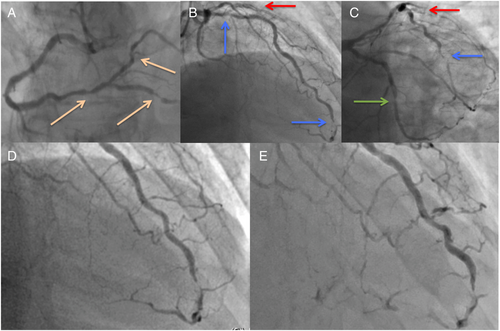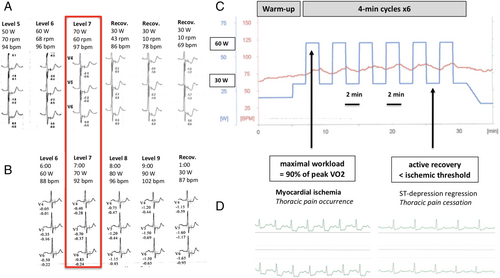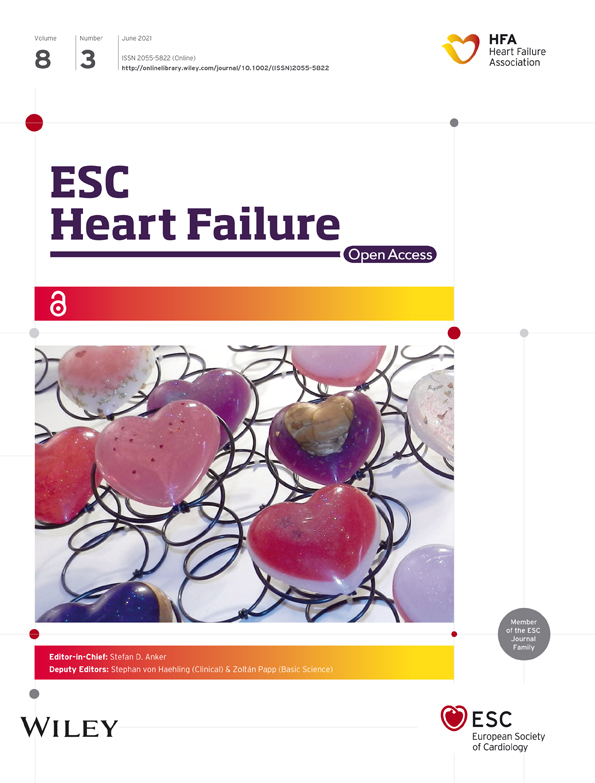Cardiac rehabilitation with intermittent myocardial ischaemia as a new therapeutic option in refractory angina?
Abstract
A 72-year-old man daily suffered from a refractory angina consecutive to a diffuse coronary artery disease despite optimal medical management. Revascularization could not be performed because of a severe thrombopenia. He was referred to our outpatient cardiac rehabilitation programme where he was candidate for 20 sessions, three times a week, of high-intensity aerobic interval training involving brief episodes of regressive myocardial ischaemia. After 7 weeks, exercise capacity (+28.5%), VO2 peak (35.7%), and ischaemic threshold increased while clinical status and quality of life improved. No adverse effect was reported. Aerobic interval training with myocardial ischaemia might be a therapeutic alternative in refractory angina.
Introduction
Many patients suffer from refractory angina consecutive to coronary artery disease (CAD) with no possibility of revascularization despite anti-ischaemic medical therapy.
Cardiac rehabilitation (CR) by improving endothelial dysfunction and increasing the growth of collateral coronary arteries1 appears as one therapeutic option.2
However, while we know the benefits of exercise-induced claudication in peripheral artery disease3 and the occurrence of myocardial endogenous cardioprotective mechanisms after brief intermittent ischaemic episodes,4 traditional training exercise do respect the ‘sacrosanct dogma’ of the threshold for myocardial ischaemia and must be prescribed at a target heart rate remaining 10 b.p.m. below the ischaemic threshold.2
With the objective to attenuate symptoms, we designed a new CR protocol with aerobic interval training (AIT) including intermittent myocardial ischaemia.
Case report
A 72-year-old patient presented a stable CAD with disabling refractory angina for 2 months (Canadian Cardiovascular Society class III angina) despite medical therapy including Aspirin, Atorvastatin, Bisoprolol of 5 mg, Amlodipine of 5 mg, Nicorandil of 20 mg bid, and Trimetazidine of 35 mg bid. Nitrates were not tolerated. The left ventricular ejection fraction was normal.
Coronary angiography, performed after a positive exercise test, has shown a diffuse calcified multivessel CAD with distal lesions unsuitable for coronary artery bypass graft (Figure 1). Coronary angioplasty could technically be performed. However, considering a severe thrombopenia of 30 000/mm3 consecutive to chronic lymphoid leukaemia, dual antiplatelet therapy was temporarily contraindicated.

So he was referred to our CR centre. The initial maximal cardiopulmonary exercise test (10 W + 10 W/min) on a bicycle ergospirometer (Ergoline Ergoselect 100) performed under his usual anti-ischaemic treatment objectived an early symptomatic ischaemia since 40 W workload with the occurrence of thoracic pain and significant downsloping ST depression of 1 mm in V5–V6 leads (designed as the angina and ischaemic threshold), at a pulse of 95 b.p.m., aggravating until the maximal workload at 70 W (ST depression > 2.5 mm in V4–V5–V6 leads) (Figure 2). Indexed VO2 peak was 14 mL/kg/min whereas the first ventilatory threshold (VT) was determined at a pulse of 90 b.p.m. for a 30 W workload.

After information about the benefits and potential risks of the protocol, the patient consented to be candidate for an exercise training above the ischaemic threshold.
The outpatient CR programme included not only 20 sessions of cyclo-ergometric AIT, three times a week, but also resistive exercise and educational sessions.
The AIT protocol consisted in six cycles alternating of 2 min periods of exercise at very high intensity (90% of peak VO2) with myocardial ischaemia, with 2 min intervals at a moderate intensity (at the VT, below the ischaemic threshold) (Figure 2).
All the exercise sessions, including also 5 min warm-up and 5 min cool-down phases and lasting 32 min, were performed under a 3-lead electrocardiographic monitoring and the supervision of a trained healthcare professional.
On completion of the 20-session programme, while his anti-ischaemic treatment remained unchanged, his symptoms were significantly reduced to Canadian Cardiovascular Society class I, and quality of life measure with the use of the Seattle Angina Questionnaire was improved by 32 points.
The final evaluation test remained positive for myocardial ischaemia, but the ischaemic threshold was delayed from 40 to 80 W. The peak workload increased at 90 W (+28.6%), and the indexed peak VO2 improved at 19 mL/kg/min (+35.7%) (Figure 2). The VT improved from 30 to 50 W.
Except exercise-induced chest pain, the training was well tolerated, with no significant exercise adverse event (particularly no arrhythmia and no acute coronary syndrome).
One year later, the clinical and aerobic benefits were maintained. A new maximal cardiopulmonary exercise test is performed. It always shows the same significant gain in aerobic exercise capacity. A second coronary angiogram seemed to show not only a stability of the coronary artery native lesions but also the growth of new epicardic collateral arteries (Figure 1).
Discussion
We reported new CR protocol using AIT with intermittent and repeated periods of myocardial ischaemia as a new therapeutic option in refractory angina. This CR protocol can be very useful in patients with refractory angina who cannot benefit from percutaneous coronary intervention or coronary artery bypass graft revascularization.
By analogy with the substantial benefits with regular walking in peripheral arterial disease of the lower limbs,3 knowing also that myocardial cell induced cardioprotective mechanisms,4 we designed an innovative exercise protocol based on AIT including short (2 min) and repeated (6 cycles per session) periods of myocardial ischaemia, mimicking pre-conditioning, for management of refractory angina.
After 20 sessions, this protocol improves the patient's clinical status, quality of life, and aerobic exercise capacity, without pro-arrhythmic effect, and seems to participate in the growth of collateral coronary arteries.
Such strategy had already demonstrated the safety of repeated myocardial ischaemia in 11 patients with CAD.5
Further studies, involving larger number of patients, are needed to first evaluate the safety and efficacity on quality of life of this under-utilized strategy and then to focus on reducing the risk of major adverse cardiovascular events (ischaemic event, death, etc.).
Conflict of interest
None declared.




